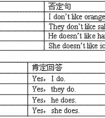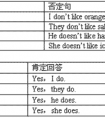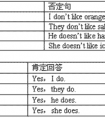句型转换。1. They do their homework every day. (用now改写句子)Theytheir homework now. 2. Tom is looking at a picture. (改为一般疑问句并作出肯定回答)- Tomat -七年级英语
We're flying to Paris tomorrow.(我们明天乘飞机去巴黎)现在进行时的应用
D .些非持续性动词的进行时可以表示动作即将进行或发生,或表示动作的重复。
例如:He is joining the army.
E.当现在进行时中有always, forever, constantly, continually修饰时,表示说话人的
赞赏或厌烦的情绪。
例如:They are always helping us.
注意:表示状态、感觉、心理活动的静态动词时,一般不使用进行时态。
F.子中有now时,常表示动作正在进行,这时要用现在进行时。如:
They are playing basketball now.现在他们正在打篮球。
G.ook, listen开头的句子,提示我们动作正进行,这时要用现在进行时。如:
Listen!She is singing an English song.听,她正在唱英语歌。
H.当前一段时间或现阶段正在进行的动作,且此时有this week, these days等时间状语,这时常用现在进行时。如:
We are making model planes these days.这些天我们在做飞机模型。
I.图片中的人物的动作,也为了表达更生动。此时也常用现在进行时。如:
Look at the picture. The children are flying kites in the park.看这幅图,那些孩子正在公园放风筝。
考点名称:疑问代词
疑问代词:
疑问代词在句中起名词的作用,用来构成疑问句。常用的疑问代词有:
what, who, whose, whom, which, whatever, whichever, whoever, whomever
疑问代词在句中应位于谓语动词之前,没有词性和数的变化,除who之外也没有格的变化。
what, which, whose还可作限定词。
Whose books are these on the desk?
桌上的书是谁的?
What was the directional flow of U. S. territorial expansion?
美国的领土扩张是朝哪个方向的?
What events led to most of the east of the Mississippi River becoming part of the United States?
哪些事件使密西西比河以东的大部分土地归属于美国?
疑问代词在句中起名词词组的作用,用来构成疑问句。疑问代词有下列几个:
指 人: who, whom, whose
指 物: what
既可指人又可指物: which疑问代词说明:
一、无论是做疑问代词还是限定词,which 和 what 所指的范围不同。what所指的范围是无限的,而which则指在一定的范围内,例如:
Which girls do you like best?
你喜欢哪几个姑娘?
What girls do you like best?
你喜欢什么样的姑娘?二、Whom是who的宾格,在书面语中,它作动词宾语或介词宾语,在口语中作宾语时,可用who代替,但在介词后只能用whom, 例如:
Who(m) did you meet on the street?
你在街上遇到了谁?(作动词宾语)
Who(m) are you taking the book to?
你要把这书带给谁?(作介词宾语,置句首)
To whom did you speak on the campus?
你在校园里和谁讲话了?(作介词宾语,置介词 后,不能用who取代。)三、疑问代词用于对介词宾语提问时,过去的文体中介词和疑问代词通常一起放在句首,现代英语中,疑问代词在句首,介词在句未,例如:
For what do most people live and work?大部分人生活和工作的目的是什么?(旧文体)
What are you looking for?你在找什么?(现代英语)四、疑问代词还可引导名词性从句,例如:
I can't make out what he is driving at.
我不知道他用意何在。
Can you tell me whose is the blue shirt on the bed?
你能告诉我床上的蓝衬衣是谁的吗?
Much of what you say I agree with, but I cannot go all the way with you.
你说的我大部分同意,但并不完全赞同。- 疑问代词用法:
1. 疑问代词有who, whom, whose, which和what, 都是用来构成疑问句的:
Who is calling? 谁打电话来?
Whom do you want to speak to? 你想找谁接电话?
作主语时用who,作宾语时用whom,在口语中用who作宾语时也不少:
Who did you mean? 你指的是谁?
Who are you talking about? 你们在讲谁?
直接跟在介词后时只能用whom:
With whom did you come? 你和谁一道来的?
(口语中说“Who did you come with?时更多一些。)
2. 其他三个疑问代词可用作:
1)主语:
What’s your address? 你的地址怎样写?
Whose is better? 谁的好一些?
Which of these is yours? 哪一本是你的?
2)宾语:
What do you mean? 你是什么意思?
Which do you like better? 哪一个你更喜欢一些?
Whose have you chosen? 你选了谁的?
3)表语:
What’s her name? 她叫什么名字?
Whose is it? 这是谁的?
4)定语(这样用时有些字典标作形容词):
What time does the train leave? 这列火车什么时候离开?
Which room shall we stay in? 我们住哪间房?
Whose passport is this? 这是谁的护照?
考点名称:疑问副词
- 疑问副词:
用来引导特殊疑问句,表示时间,地点,方式,原因等。
常见的有:when,where,how,why等。 疑问副词的用法:
1.疑问副词是问何时、何地、如何、因何的副词,主要有when, where, how, why。
2.疑问副词用在句首。
How long have you been staying in America?
你在美国待多久了?3.疑问副词在句中引导名词子句。
I want to know where she has gone.
我想知道她去哪里了。4.疑问副词后接不定词构成的名词片语,在句中可以作主词、受词或主词补语。
How to solve the problem gives him a bad headache.
如何解决这个问题使他伤透脑筋。
(How to solve the problem作主词。)
I don't know how to answer the question.
我不知道如何回答这个问题。
(how to answer the question作受词。)
The patient is in urgent need the medicine, but the problem is where to get it.
这个病人急需这种药,但问题是哪里能找到。
(where to get it作主词补语。)5.疑问副词引导的名词子句可作主词、受词或主词补语。
When we are to start the competition hasn't fixed yet.
我们什么时候开始比赛还没有定下来。
(When we are to start the competition作主词。)
She asked her husband where he had been.
她问她丈夫去哪里了。
(where he had been 作受词。)
The question is when we can finish our work.
问题是我们何时能完成我们的工作。
(when we can finish our work作主词补语。)- 疑问代词与疑问副词的区别:
1. 疑问代词做对陈述句的主语,宾语或定语提问,即做句子的主语,宾语或定语,如what, who/ whom, whose.
eg. Who is talking ? What can you see?
Whose shirt is this?
2.疑问副词对时间,地点,方式等状语提问,如when, where, how 等.
eg. When is your birthday? Where are you going?
How do you know?
常见的疑问代词:what who which whom(只做宾语)
疑问副词:how where when
还有whether是疑问连接词。
考点名称:一般疑问句
- 一般疑问句:
是疑问句的一种。通常用yes,no来回答的疑问句叫做一般疑问句。口语中若无特殊含义,句末用升调。
其结构是:系动词be/助动词/情态动词+主语+其他成分?
通常回答为:
肯定:Yes+主语+提问的助动词
否定:No+主语+提问的助动词+not
例如:
Are you from Japan? Yes, I am./No, I'm not.
Do you live near your school? Yes, I do./No, I don't.
Can you speak French? Yes, I can./No, I can't. - 一般疑问句的特性:
1.将陈述句变为一般疑问句时,如句中有be 动词(am/ is/ are)时,可直接将它们提至主语前。
如主语为第一人称,应将其改为第二人称。如:
I'm in Class 2Grade 1. →Are you in Class 2Grade 1﹖
We're watching TV. →Are you watching TV﹖
2.陈述句中有情态动词(can、may、must …)时,也可直接将它们提至主语前,即可成为一般疑问句。如:
He can swim now. →Can he swim now﹖
The children may come with us. → May the children come with us﹖
3.陈述句中只有一个实义动词作谓语且其时态为一般现在时,变为一般疑问句时要在句首加do或does主语后的实义动词用原形。如:
I like these animals. →Do you like these animals﹖
She wants to go to the movies. → Does she want to go to the movies﹖
4.一般疑问句一般读升调(↑)
5.一般疑问句有时不用yes或 no 回答。如:
Are they in town now﹖
I think so.
May I sit here﹖
- 最新内容
- 相关内容
- 网友推荐
- 图文推荐
| [家长教育] 孩子为什么会和父母感情疏离? (2019-07-14) |
| [教师分享] 给远方姐姐的一封信 (2018-11-07) |
| [教师分享] 伸缩门 (2018-11-07) |
| [教师分享] 回家乡 (2018-11-07) |
| [教师分享] 是风味也是人间 (2018-11-07) |
| [教师分享] 一句格言的启示 (2018-11-07) |
| [教师分享] 无规矩不成方圆 (2018-11-07) |
| [教师分享] 第十届全国教育名家论坛有感(二) (2018-11-07) |
| [教师分享] 贪玩的小狗 (2018-11-07) |
| [教师分享] 未命名文章 (2018-11-07) |






